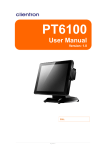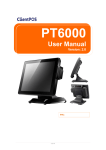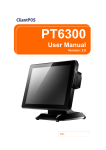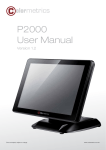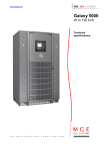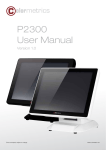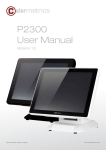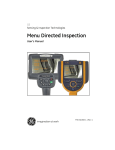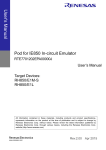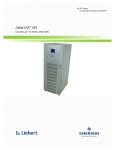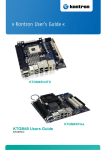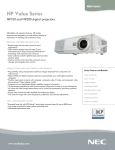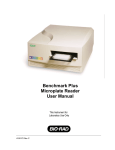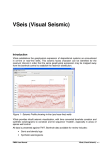Download P2100 User Manual
Transcript
P2100 User Manual Version 1.0 Errors excepted; subject to change www.colormetric.net 2 Colormetrics P2100 www.colormetric.net TABLE OF CONTENTS COPYRIGHT 4 SAFETY INSTRUCTIONS 5 1 PACKING LIST 6 1-1. Standard Accessories 6 1-2. Optional Accessories 6 2 SYSTEM VIEW 7 2-1. Rear View with Optional LPT Port 7 2-2. Specification 8 2-3. Internal Layout 9 3 PIN DEFINITION 10 4 REAR I/O INTERFACE 12 5 SYSTEM ASSEMBLY & DISASSEMBLY 14 5-1. HDD 14 5-2. CF- Card 14 5-3. MSR 16 5-4. UPS Battery 16 5-5. Cable Cover 17 5-6. 15” 2nd Display 5-7. Internal VFD 17 21 5-8. Wi-Fi 5-9. 8” 2nd Display 5-10. 1D / 2D / iButton with RFID Module 5-11. Pole type VFD VD1220 22 24 27 28 6 DEVICE DRIVER INSTALLATION 30 6-1. Resistive Type Touch Panel & P-CAP 30 6-2. MagStripe Card Reader Configuration Utility 36 6-3. Fingerprint Reader 51 6-4. RFID 6-5. Internal VFD 6-6. Configuration Utility of I-Button Reader 6-7. Installation and Testing of Smart Card Reader 6-8. WiFI 6-9. Pole type VFD VD1 61 71 75 86 94 7 BIOS/UTILITY SETUP 99 8 LCD SURFACE CLEANING 110 www.colormetric.net Colormetrics P2100 3 COPYRIGHT Copyright 2014 Publishing. All Rights Reserved. This manual, software and firmware described in it are copyrighted by their respective owners and protected under the laws of the Universal Copyright Convention. You may not reproduce, transmit, transcribe, store in a retrieval system, or translate into any language, in any form or by any means, electronic, mechanical, magnetic, optical, chemical, biological, molecular, manual, or otherwise, any part of this publication without the express written permission of the publisher. All products and trade names described within are mentioned for identification purpose only. No affiliation with or endorsement of the manufacturer is made or implied. Product names and brands appearing in this manual are registered trademarks of their respective companies. The information published herein has been checked for accuracy as of publishing time. No representation or warranties regarding the fitness of this document for any use are made or implied by the publisher. We reserve the right to revise this document or make changes in the specifications of the product described therein at any time without notice and without obligation to notify any person of such revision or change. 4 Colormetrics P2100 www.colormetric.net SAFETY INSTRUCTIONS 1. Read these instructions carefully. Keep these instructions for future reference. 2. P lease disconnect this equipment from AC outlet before cleaning. Don’t use liquid or sprayed detergent for cleaning. Use moisture sheet or cloth for cleaning. 3. Please keep this equipment from humidity. 4. Lay this equipment on a reliable surface when install. A drop or fall could cause injury. 5. M ake sure power cord such a way that people can not step on it. Do not place anything over the power cord. 6. All cautions and warnings on the equipment should be noted. 7. If the equipment is not used for long time, disconnect the equipment from main to avoid being damaged by transient over voltage. 8. Never pour any liquid into opening, this could cause fire or electrical shock. 9. If one of the following situations arises, get the equipment checked by a service personnel: a. The power cord or plug is damaged. b. Liquid has penetrated into the equipment. c. The equipment has been exposed to moisture. d. The equipment does not work well or you can not get it work according to user manual. e. The equipment has dropped and damaged. 10. D o not leave this equipment in an environment unconditioned, storage temperature below -20°C or above 60°C, it may damage the equipment. 11. Unplug the power cord when doing any service or adding optional kits. Lithium Battery Caution: Danger of explosion can happen if the battery is incorrectly replaced, Replace only the original or equivalent type recommended by the manufacture. Dispose used batteries according to the manufacture’s instructions. Do not remove the cover, and ensure no user serviceable components are inside. Take the unit to the service center for service and repair. www.colormetric.net Colormetrics P2100 5 PACKING LIST 1-1. Standard Accessories MODULES*: MSR 1D/ 2D BARC NER RFID (13,56M IBUTTON SMARTCARD FINGERPRINT a. System (with stand) b. Power Adapter c. Power Cord d. Driver Bank e. Screw f. Cable Cover 1-2. Optional Accessories Modules*: Accessories: MSR Build-in VFD 1D/2D barcode scanner Pole VFD RFID (13,56 MHz) 8” pole customer display iButton 15” pole customer display Smart card reader UPS battery Fingerprint reader *Note: Nearly all modules are also available as 2-in-1 or 3-in-1 solution. 6 Colormetrics P2100 www.colormetric.net Optional LPT Port 2 SYSTEM VIEW 2-1. Rear View with Optional LPT Port ard Rear View Standard CODE SCAN- MHZ) D READER T READER * Please sureplug 19V DC plug right in the right *Please make sure make 19V DC in the direction before plugging in DC jack. direction before plugging in DC jack. TON/Fingerprint/RFID(Option) Item 1.19V DC Input 8. USB 2.0/1.1 X4 9. RJ45(LAN) 2.PS2(K/B) 10.RJ11(Cash Drawer) 3.RJ45(COM 4 for External VFD) 7 4.UPS Battery(Option) 11.Line-Out 5.COM2 17. HDD/CFast CARD 18.VFD(Option) 12.Mic 13.COM1 6.COM3 14.Parallel port (Option :Alterative to COM 3) 7.VGA 15.Power Button www.colormetric.net 16.MSR/Smart Card/i-Button /Fingerprint /RFID (Option) Colormetrics P2100 7 2-2. Specification Processor Intel® Celeron J1900 Quad Core 2.0Ghz Memory One SO-DIMM socket supports DDR3L up to 8GB Audio Line-out/Mic-in Network RJ45 10/100/1000 Base-T USB 4*USB 2.0 Storage CFast card / 2.5” SATAII HDD / SSD BIOS Insyde BIOS Power AC 19V 90W Adaptor Thermal Solution Fan-less Dimension 368 (W) x 264.2 (H) x 285 (D) mm Operating Temperature 0°C ~ 35°C Storage Temperature -20°C ~ 60°C Storage Humidity 20% ~ 80%, non-condensing Display LCD Panel Size 15-inch TFT LED LCD Resolution 1024*768 Pixels Brightness 350 cd/m2 Touch Panel 5-wire Resistive Type / Projected Capacitive Type optional Note: Intel® Celeron J1900 CPU does not support POSReady 2009 8 Colormetrics P2100 www.colormetric.net 2-3. Internal Layout www.colormetric.net Colormetrics P2100 9 3 PIN DEFINITION 1. COM 5 for Touch Panel (CN 7) Pin Function Pin Function Pin Function 1 T_UR 3 T_SG 5 T_LR 2 T_UL 4 T_LL 2. Parallel J1 Pin NO. Pin Name Description Pin NO. Pin Name Description 1 STB# Printer Strobe 14 AFD# Printer Auto Line Feed 2 PD0 Parallel Port DATA0 15 ERR# Printer Error 3 PD1 Parallel Port DATA1 16 INIT# Printer Initialize 4 PD2 Parallel Port DATA2 17 SLIN# Printer Select Input 5 PD3 Parallel Port DATA3 18 GND Ground 6 PD4 Parallel Port DATA4 19 GND Ground 7 PD5 Parallel Port DATA5 20 GND Ground 8 PD6 Parallel Port DATA6 9 PD7 Parallel Port DATA7 10 ACK# Printer Acknowledge 11 BUSY Printer Busy 12 PE Printer Paper End 13 SLCT Printer Select 3. Line-out J2 Pin NO. Pin Name Description 1 GND Ground 2 GND Ground 3 Line OUT R Line out 4 Line OUT L Line out 5 Detect Detect 4. VFD Connector CN12 Pin NO. Pin Name Description 1 5V +5V 2 NDSR DSR 3 GND Ground 4 NRTS DTR 5 NRTS RTS 6 NCTS CTS 7 NTXD TXD 8 NRXD RXD 9 GND Ground 10 12C +12V 10 Colormetrics P2100 www.colormetric.net 5. Mic J3 8. Inverter CN9 Pin NO. Pin Name Description Pin NO. Pin Name Description 1 GND Ground 1 VCC +12V 2 GND Ground 2 GND Ground 3 Mic R Mic 3 NC NC 4 Mic L Mic 4 BKL_CTL Back Light Brightness 5 Detect Detect 5 BKL_EN Back Light Enable 6. Speaker SP1 9. Extra USB CN8 Pin NO. Pin Name Description Pin NO. Pin Name Description 1 + Speaker + 1 VCC +5V 2 - Speaker - 2 - DATA D- 3 + DATA D+ 4 GND Ground 5 GND Ground 7. LVDS CN 13 Pin NO. Pin Name Description 1 GND Ground 2 GND Ground 3 DATA 3+ LVDS Output DATA3+ 4 DATA 3- LVDS Output DATA3- 5 GND Ground 6 CLK+ LVDS CLK+ 7 CLK- LVDS CLK- 8 GND Ground 9 DATA 2+ LVDS Output DATA2+ 10 DATA 2- LVDS Output DATA2- 11 GND Ground 12 DATA 1+ LVDS Output DATA1+ 13 DATA 1- LVDS Output DATA1- 14 GND Ground 15 DATA 0+ LVDS Output DATA0+ 16 DATA 0- LVDS Output DATA0- 17 GND Ground 18 GND Ground 19 LVDVCC +3.3V 20 LVDVCC +3.3V www.colormetric.net Colormetrics P2100 11 4 REAR I/O INTERFACE 1. COM1’ COM2’ COM3 port 4 Pin Signal Function 1 CD Carrier Detect (IN) RD Rear2I/O Interface 3 Receive Data (IN) TD Transmit Data(OUT) DTR 1. COM1’4COM2’ COM3 port 5 2. GND 6 Signal Pi n 1 2 3 4 Data Terminal Ready(OUT) Ground DSR Function 7 Data Set Ready (In) Pin RTS Request To Send (OUT) CD Carrier Detect (IN) 6 8 CTS Clear To Send (IN) RD Receive Data (IN) 7 9 Ring/5V/12V Setting by BIOS 8 TD Transmit Data(OUT) DTR Data Terminal Ready(OUT) 9 port. Warning!! GND GroundCOM4 (RJ45 Connector ) for 5COM4 Signal Function DSR RTS CTS Ring/5V/12V Data Set Ready (In) Request To Send (OUT) Clear To Send (IN) Setting by BIOS COM 4 port will be inactive if POS has internal external VFD use only. Never use on network device. VFD. (Alternative of COM 4 or internal VFD) COM4 port . Warning!! COM4 (RJ45 Connector If you are using on the network device will cause the ) for external VFD use only. Never use on network device. If you are using on the network device will cause the device damaged. device damaged. Pin 1: +5V / +12V Pin 2: DSR# Pin 3: GND Pin 4: DTR# Pin 5: RTS# Pin 6: CTS# Pin 7: TxD Pin 8: RxD 1 2 3 4 5 6 78 Jumper for COM4 Voltage Setting 2. VGA port VGA port Pin I/O Function 1 Out Red Video 2 Out Green Video 3 Out Blue Video 4 In Monitor ID 2 5 - TTL Ground (Monitor Self Test) - Red Analogue Ground - Green Analogue Ground 8 - Blue Analogue Ground 9 - Key (Plugged Hole) 10 - Sync Ground 11 In Monitor ID 0 In Monitor ID 1 13 Out Horizonal Sync 14 Out Vertical Sync 15 In Monitor ID 3 6 3. USB port 7 12 port 4. PS/2 K/B 12 Colormetrics P2100 Enlarge JUMP www.colormetric.net 3. USB port 4. PS/2 K/B port Pin Signal Name Wire Colour Comment 1 Vcc Red Cable Power 2 - Data White Data Transfer 3 + Data Green Data Transfer 4 Ground Black Cable Ground Shell Shield - Drain Wire 5. LAN port Pin Signal Name 1 Data from Device 2 Not Connected 3 Ground 4 +5V DC 5 Clock 6 Not Connected 6. RJ11 port (for Cash drawer) Pin Wire Colour Description Pin Signal Name Direction 1 White/Orange Transmit 1 Frame GND - 2 Orange Transmit 2 Output 3 White/Green Receive 4 Blue Not Used Drawer Kickout drive signal 1 5 White/Blue Not Used 3 Input 6 Green Receive Cash Drawer Status 7 White/Brown Not Used 4 +12V - 8 Brown Not Used 5 N/C - 6 Signal GND - 7. DC Jack Pin Signal Name 1 DC IN 19V 2 Ground 3 DC IN 19V Example DOS COMMAND for Cash Drawer: 1. Create the file: TEST.TXT 2. Input below contents in TEST.TXT CONTEXT-"000.0” MODE COM6:300 3. Run COMMAND under DOS mode COPY TEST.TXT COM6 www.colormetric.net Colormetrics P2100 13 5 SYSTEM ASSEMBLY & DISASSEMBLY 5 System Assembly & Disassembly 5-1. HDD 5-1. HDD UP thethe HDD cover screw*2 1.1. Unfasten Unfasten HDD cover screw*2 2.2. Pull Pulloutout HDD bracket thethe HDD bracket 3. Fasten the screw*4 4.3. Fasten Placethe thescrew*4 HDD bracket back to the module 4. Place the HDD bracket back to the module 5-2. MSR 5-2. CF-Card 1. Please notice the unnotched CFast Card . This side up. 1. 2. 3. 4. 14 Open the MSR cover Single MSR or 4in1MSR Screw*2 M3x10L Fasten the screw Colormetrics P2100 www.colormetric.net 5-3. UPS Battery 14 2. Before Installing CF Card. 3. After Installing CF Card. www.colormetric.net Colormetrics P2100 15 1. 2. 3. 4. Unfasten the HDD cover screw*2 Pull out the HDD bracket Fasten the screw*4 Place the HDD bracket back to the module 5-3. MSR 5-2. MSR 1. Open the MSR cover 2. Single MSR or 3-in-1 MSR 3. Screw*2 M3x10L 4. Fasten the screw 1. Open the MSR cover 2. 5-4. SingleUPS MSRBattery or 4in1MSR 3. Screw*2 M3x10L e two rubbers on the located position of the Stand Bracket. 4. Fasten the screw Positioning hole 5-3. UPS Battery 14 ve two cable ties through the stand bracket. Place the battery pack in (2) Reeve two cable ties through the stand (1) Paste two rubbers on the located position and bind the cable ties tightly. Then cut the extra tail from cable ties. bracket. Place the battery pack in position of the Stand Bracket. ning hole and bind the cable ties tightly. Then cut the extra tail from cable ties. ve the cable from the battery pack through the stand bracket and click the ck. ble cover (3) Reeve the cable from the battery pack through the stand bracket. 16 Colormetrics P2100 www.colormetric.net itioning hole ve the cable from the battery pack through the stand bracket and click the ck. ble cover 5-5. cable cover eeve the cable from the battery pack through the stand bracket and click the e lock. cable cover ble the cable cover from bottom and make sure the two latches are on the sition. Then 2 screws mble the cablefasten cover from bottom(M3*5L). and make sure the two latches are on the position. Then fastenthe2 screws (M3*5L). Assemble cable cover from bottom and make sure the two latches are on the right position. Then fasten 2 screws (M3*5L). 5” 2nd 15” 2ndDisplay Display 15 15 www.colormetric.net Colormetrics P2100 17 * Power supply must be replaced to 120W above power adapter. (1) Remove the plastic pole cover from the stand. 5-6. 8"/15" 2nd Display * Power supply be replaced to 120W above power adapter. * Power supply must be replaced to 120W above power must adapter. (1) Remove the plastic pole cover from the stand. (2) Install the pole into the socket in clockwise direction. * Power supply must be replaced to 120W above power adapter. (1) Remove the plastic pole cover from the stand. (2) Install the pole into the socket in clockwise direction. (1) R emove the plastic pole cover from the stand. (2) Install the pole into the socket in clockwise direction. (3) Fasten the four screws (M4*8L) to joint the VESA bracket and the rear cove (3) Fasten the four screws (M4*8L) to joint the VESA bracket and the rear (3) Fasten the four screws (M4*8L) to joint the VESA bracket and the rear cover. (2) Install the pole into the socket in clockwise direction. (3) Fasten the four screws (M4*8L) to joint the VESA bracket and the rear cover. (4) Connect the COM port, DC cable as shown in figure . (Please refer to pag 60 to set the COM port pin9 with 12V DC output.) (5) Connect the VGA cable as shown in figure . 16 (4) Connect the COM port, DC cable as shown in figure . (Please refer to page (4) Connect the COM port, DC cable as shown in figure 60 to set the COM port pin9 with 12V DC output.) 60 to set the COM port pin9 with 12V DC output.) (5) Connect the VGA cable as shown in figure . 16 . (Please refer t (5) Connect the VGA cable as shown in figure . 16 18 Colormetrics P2100 www.colormetric.net (8) Route the cables through the opening of stand front cover and cable clip at bottom and route the cables into the tube of pole. 6) Connect the audio cable as shown in figure. 7) Assemble the cable cover from bottom and make sure (9) the two latches on Reeve theare cables the right position, and fasten the two screws (M3*5L). (4) Connect the COM port, DC cable as shown in figure (1). (Please refer to page 12 to set the COM port pin9 with 12V DC output.) out of the tube. (8) Route the cables through the opening of stand front cover and cable clip at the bottom and route the cables into the tube of pole. (5) Connect the VGA cable as shown in figure (2). (6) Connect the audio cable as shown in figure(3). (7) Assemble the cable cover from bottom and make sure the two latches are on the right position, and fasten the two screws (M3*5L). 17 8) Route the cables through the opening of stand front cover and cable clip at the bottom and route the cables into the tube of pole. (10) Mount the VESA bracket on the pole and route cables out of the tube of VES bracket. Fasten the thumb screw to fix the VESA bracket. 9) Reeve the cables out of the tube. Mount the VESA bracket on the pole and route cables(11) out of the tube of DC VESA Connect the power cable as shown in figure. ket. Fasten the to fix the (10)cable Mountasthe VESAinbracket on the pole and (9)thumb Reevescrew the cables out VESA of the bracket. tube. (12) Connect the VGA shown figure. 17 route cables out of the tube of VESA (13) Connect the Audio cable as shown in figure. bracket. Fasten the thumb screw to fix the VESA bracket. Connect the DC power cable as shown in figure. Connect the VGA cable as shown in figure. www.colormetric.net Connect the Audio cable as shown in figure. Colormetrics P2100 19 as shown in figure. (11) Connect the DC power cable wn in figure. sho as le (12) Connect the VGA cab wn in figure. sho as le (13) Connect the Audio cab bracket. VESAcable e of (11) Connect the DC power as shown in figure (1). (14) Put the cable cover on the hing 18 as shown in figure (2). (12) C onnect the VGA cable (13) Connect the Audio cable as shown in figure (3). (14) Put the cable cover on the hinge of VESA bracket. 19 20 Colormetrics P2100 www.colormetric.net 5-7. Internal VFD Item Operation procedure Remark 1 Prepare all components as Fig 1 2 Assemble holder & hinge assy by TAPPING SCREW P/H 2.6φ*5 x2 pcs(As Fig 2) Torque 2Kgf 3 Fix VFD module on holder assy by TAPPING SCREW P/H 2.6φ*5 x4 pcs as Fig 3 Torque 2Kgf 4 Screw VFD module on VFD cover by TAPPING SCREW P/H 2.6φ*5 x 2pcs AS fig 4) Torque 2Kgf 5 Fix VFD module on rear cover by TAPPING SCREW R/H M3*8L x 2pcs (As Fig 5) Torque 2Kgf 6 The VFD cable must be around to capacitor H below, so as not to interfere hinge action (As Fig 6) Item P/N and Component 1 20D990002-000B DISPLAY MODULE VFD *1 2 68D350235-000B COVER FOR VFD *1 3 78D300021-000B HOLDER FOR VFD *1 4 26D100005-000B HINGE ASSY FOR VFD *1 5 64D426051-000T SCREW TAPPING P/H 2.6φ*5 *8 6 64D430088-000T SCREW TAPPING R/H M3*8L *2 7 35D510480-000B CABLE 16P femail TO 8P female*1 Item Action item 1 Wear cotton gloves, wrist strap and may not wear watches, rings, etc. 2 Screws to lock in place and can not lost 3 Electric screwdriver Torque to be regularly calibrated, ☆ Alternative of external COM4 (RJ45 Connector) or Internal VFD. www.colormetric.net Colormetrics P2100 21 5-8 Wi-Fi 1. Connect the antenna to Wi-Fi module, fastening the Wi-Fi Module to the Rubber, then fasten WI-Fi Module and antenna on VFD cover. 2. Assemble VFD cover and Back panel with 2 screws. Then connect Wi-Fi /MSR cable to Wi-Fi module. 2. Connect Wi-Fi /MSR cable to M/B. ☆ Alternative of WiFi or Internal VFD. 22 Colormetrics P2100 www.colormetric.net 5-9 8” 2nd Display 1. Remove the plastic pole cover from the stand. 2.Install the pole into the socket in clockwise direction. www.colormetric.net Colormetrics P2100 23 3. Connect VGA cable and DC power cable 4. Fasten the four screws (M4*8L) to joint the VESA bracket and the rear cover. 5. Reeve the cables out of the tube. 24 Colormetrics P2100 www.colormetric.net 6. Mount the VESA bracket on the pole and route cables out of the tube of VESA bracket. Fasten the thumb screw to fix the VESA bracket. 7. Reeve the cables out from the bottom of pole. 8. Route the cables through the opening of stand front cover and cable clip at the bottom and route the cables into the tube of pole. 9. Connect the DC power cable as shown in figure. To setup COM port PIN9 with 12V DC output from BIOS setup, please refer to page 12, Advanced Chipset Features / COM port PIN9 setting. www.colormetric.net Colormetrics P2100 25 10. Connect the VGA cable as shown. 11. Put the cable cover on the hinge of VESA bracket. 26 Colormetrics P2100 www.colormetric.net 5-10. 1D / 2D / iButton with RFID Module (1) Cable installation. For iButton with RFID module; For 2D barcode scanner with RFID module: Connect the cable as shown. (3) Fix the screws as shown. (2) For 1D barcode scanner with RFID module: Connect the cable as shown. * Before COM port cable connection, please setup COM port PIN9 with 5V DC output from BIOS setup. Please refer to page 12, Advanced Chipset Features / COM port PIN9 setting. www.colormetric.net Colormetrics P2100 27 5-11 Pole type VFD VD1220 1 Take VFD panel and two VFD poles out from the package box and Install two tubes into one pole and reeve the cable from the VFD panel through the socket of stand. VFD Panel VFD Pole 2 For the foot ring assembly, please install the foot ring into the socket in clockwise direction. 28 Colormetrics P2100 www.colormetric.net 3 Then install the pole into the foot ring. 4 Then connect RJ45 cable to POS terminal’s RJ45 port www.colormetric.net Colormetrics P2100 29 6 DEVICE DRIVER INSTALLATION 6-1. Resistive Type Touch Panel and P-CAP 1. Click “Next” 2. Click “Next” 30 Colormetrics P2100 www.colormetric.net 3. Click “Next” 4. Select “None”, Click “Next”. 5. Click “OK” www.colormetric.net Colormetrics P2100 31 6. Select “Support Multi-Monitor System”, Click “Next”. 7. Click “Next”. 32 Colormetrics P2100 www.colormetric.net 8. Click “Next”. 9 Click “Next” www.colormetric.net Colormetrics P2100 33 10. Select “Create a eGalaxTouch Utility shortcut on desktop”, Click “Next”. 34 Colormetrics P2100 www.colormetric.net 11. Would you do 4 point calibration now? Click “Yes”. 12. Do 4 points aligrment to match display 13. Calibration utility www.colormetric.net Colormetrics P2100 35 6-2. MagStripe Card Reader Configuration Utility 1 Combo USB HID MSR The MagStripe Card Reader Configuration Utility is used to set up the output format of HIDMSR-20 Installation Below steps guide you how to install the Utility program. 1 Insert the setup CD 2 Run the HIDMSR-20 Utility.exe setup file that is located in the Software folder of CD. 3 Follow the wizard to complete the installation. Launching Program Below steps guide you how to load the Utility program. 1 From Start/Programs, click HIDMSR20 folder 2 Click MagStripe Card Reader Configuration Utility to launch the program. 1 The utility program will detect the connected reader. If detected, all the input text boxes will be enabled. 2 If the reader has not been connected to PC yet, please connect the reader and then click Refresh to get connected. 36 Colormetrics P2100 www.colormetric.net Configuration Below is the main window of Utility program. For the settings, there are: 1 L anguage: The language defines the code positions of the keyboard. Each language should use its own settings. Wrong language selected will cause the wrong character displayed. 2 P refix/Suffix: Defines the data string which you would like to append in front or end of the MSR data string. 3 Error Message: Indicates which track number cause the error. 4 Delimiter: Indicates the swipe result. 5 ISO: Define start and end sentinel character. 6 Decode Mode: Determines the way of outputting the three tracks data. www.colormetric.net Colormetrics P2100 37 Shown below is the data structure of the output string for MSR. PP PR1 SS1 TK1 ES1 SU1 PR2 SS2 TK2 ES2 SU2 PR3 SS3 TK3 TK3 SU3 SU DM 1 PP: Prefix for package. 1 SU2: Suffix for track 2. 2 PR1: Prefix for track 1. 2 PR3: Prefix for track 3. 3 SS1: Start sentinel for track 1. 3 SS3: Start sentinel for track 3. 4TK1: Data for track 1, if error happens, using Error Message instead. 4TK3: Data for track 3, if error happens, using Error Message instead.. 5 ES1: End sentinel for track 1. 5 ES3: End sentinel for track 3. 6 SU1: Suffix for track 1. 6 SU3: Suffix for track 3. 7 PR2: Prefix for track 2. 7 SU: Suffix for package. 8 SS2: Start sentinel for track 2. 8 DM: Delimiter for the swipe result. 9TK2: Data for track 2, if error happens, using Error Message instead. 10 ES2: End sentinel for track 2. Prefix/Suffix In default, the prefix and suffix settings are all keep blank. There are 4 kinds of prefix and suffix to be defined, which are: 1 P ackage: For the prefix string, it is appended in the front of the whole MSR data. For the suffix, it is appended in the end of the whole MSR data. In most case, the suffix for package is always to be the “Enter” or “Tab” character. The max data length of the prefix and suffix for the package can be up to 127. 2 T K1: For the prefix string, it is appended in the front of the start sentinel of track 2. For the suffix, it is appended in the end of the end sentinel of track 2. The max data length of the prefix and suffix for the TK1 can be up to 127. 3 T K2: For the prefix string, it is appended in the front of the start sentinel of track 2. For the suffix, it is appended in the end of the end sentinel of track 2. The max data length of the prefix and suffix for the TK1 can be up to 127. 4 T K3: For the prefix string, it is appended in the front of the start sentinel of track 3. For the suffix, it is appended in the end of the end sentinel of track 3. The max data length of the prefix and suffix for the TK1 can be up to 127. 38 Colormetrics P2100 www.colormetric.net ISO This group defines the start and end sentinel for each track. The sentinel is always used to extract the track data from the whole MSR data string. The data length for each sentinel is fixed to one character. Because there is ISO standard that defining the start and end sentinel for the three tracks. For the compatible reason, please do not modify the default value if possible. Decode Mode For this group, it contains two kinds of settings, which are: l Track Data Filtering: Determine which track to be, not to be output or needed to be output. l Switch Output Order: Change the output order of track 1 ~ 3. Track Data Filtering Shown below is the filter setting for track 1. This provides a fool-proofing method in case of receiving unwanted or uncompleted track data. These three filter settings are: 1 Enable: If selected, the data of specified track will be packaged in the MSR data string. If the specified track data is not decoded, it will leave blank in the MSR data string. 2 Required: If selected, which means the output MSR data string must contain the specified track data. If the specified track data is not decoded, even MSR data string contains other track data, it will still not to be output. 3 Disable: If selected, the data of specified track will not be packaged in the MSR data string. No matter it is decoded or not. www.colormetric.net Colormetrics P2100 39 Switch Output Order Show below is the selection of the three track data output order (sequence). The default order is Track 1–Track 2–Track 3. There 6 orders allow to be selected. Please select one to fit your application needs. Update Settings Once complete the settings, click Update to update the settings to connected HID MSR reader. Save Settings To save the settings to a file, click Save; specify the file name and location to be saved. Open Settings To load pre-saved settings, click Open, specify the settings file, and then click OK to load into program. Restore MSR Reader Settings To load restore settings of connected MSR reader, click Restore ES2: End sentinel for track. 40 Colormetrics P2100 www.colormetric.net 2. SINGLE MSR The MagSwipe Configuration Utility is used to set up the output format of MagSwipe Installation 1 Insert the setup CD 2 Run the 80066804-006_Magswipe_Configuration_Software_V2_1_A setup file that is located in the Software folder of CD. 3 Follow the wizard to complete the installation. Launching Program Below steps guide you how to load the Utility program. 1 From Start/Programs, click MagSwipe folder 2 Click MagSwipe Configuration Utility to launch the program. www.colormetric.net Colormetrics P2100 41 Configuration Select Reader Interface The reader to be configured should be connected. Select the corresponding connected reader interface and click the Continue button 42 Colormetrics P2100 www.colormetric.net After the interface selection is made, click the Continue button. The utility attempts to communicate with the connected reader. If successful, the Home Menu Page is displayed. The Home Menu Page is shown below Change Basic Reader Setting After selecting the appropriate interface for the reader, select one of the Home Menu Page buttons to proceed with the Magnetic Stripe Reader (MSR) configuration process. The „Basic Reader Settings“ group defines the basic operating parameters and data output format of the reader. www.colormetric.net Colormetrics P2100 43 Button Definitions Send To MSR When all the setting parameters are selected, use the „Send To MSR...“ button to send configuration data to the reader device. When the reader has received the data correctly, the settings take effect immediately. Load From File The configuration data can be loaded into the configuration utility from a file that has been previously saved. Select this command, start a „File Open“ dialog, which allows selection of the file. 44 Colormetrics P2100 www.colormetric.net Save To File The configuration data can be saved as a file and being used later to configure other readers. When saving a configuration the „File Save“ dialog is opened as shown below. Input a filename and file location. Default All This button sets the reader with the default configuration parameters (the default factory settings). The settings take effect immediately. The default parameters affect all reader configurations settings. Close Close this dialog and return to the Home Menu Page. General Settings This group of configuration settings defines the basic operating parameters of the reader. www.colormetric.net Colormetrics P2100 45 MSR Reading This option will turn on or off the MSR. If MSR is disabled no data is sent out to host in any case. The default is MSR Reading Enabled. Decoding Method Settings This option gives four kinds of decoding methods. Raw Data (output in both forward and reverse directions) Decoding in Both Directions (forward and reverse reading) Decoding in Forward Direction only (card entering slot from LED end) Decoding in Reverse Direction only (card entering slot from end opposite LED) With the bi-directional operation, the user can swipe the card in both swipe directions and the data encoded on the magnetic stripe will be output. In the single swipe direction selections, the card can only be swiped in one specified direction to read the card. The default setting will decoding card data with the card swiped in either the forward or the reverse direction. „Raw Data“ is an output of the decoded magnetic stripe data in hexadecimal format (no ASCII character conversion is performed). In the Raw Data setting, the reader outputs all track-decoded data. The MSR will represent the raw data with two ASCII characters: the first ASCII character is for high bits of the raw data byte and the second is for the low bits. For example, the two ASCII characters „4“and „1“represent raw data byte 41h(01000001). Beep Volume The Beep volume can be adjusted to four loudness levels or off. Four loudness levels are: Quick High Quick Low High Low The default is High beep. Terminal Type NoteBook IBM-PC/AT IBM-PC/AT, External keyboard IBM-PC/AT, No External keyboard The firmware can be programmed to interface as a keyboard wedge to 4 different types of terminals. The default is IBM-PC/AT. Inter-Charater Delay : 2ms, 5ms, 10ms, 20ms, 50ms, 100ms; This is the time period the reader will delay between sending successive characters. Some terminals or computers (host) require an inter-character delay to simulate the effects of keystroke delays. Choosing a longer inter-character delay causes the characters to be sent at a slower rate. If the host system is not capable of receiving characters as fast as the reader 46 Colormetrics P2100 www.colormetric.net can transmit, setting an appropriate inter-character delay will keep the reader from overrunning the host input buffer. The default is 2ms. Default Page Button After you click the Default Button, the general settings page will change back to the default value. Settings are not sent to MSR until the „Send to MSR“ button is clicked. Help Button Click the help button to open the help index for this section. Pre/Postamble Preamble Characters can be added to the beginning of the reader‘s output string of data. These can be special characters for identifying a specific reading station, to format a message header expected by the receiving host, or any other character string. Up to nine ASCII characters can be defined for the Premable. Postamble The Postamble serves the same purpose as the Preamble, except the extra characters are added to the end of a data string. The Postamble can be added only after a terminator character, if specified. Track Prefix and Suffix For some Host applications, it may be convenient to start or end a string of reader data with a Sentinel or terminator character.The maximum Prefix/Suffix string is six charecters and its default is NULL(no prefix or suffix). Track Start Sentinels Characters can be added to the beginning of each track data string to simulate the start of the track data. These can be special characters for identifying a specific track. End Sentinel The magnetic stripe End Sentinel character can be added to the end of a magnetic stripe data string. This character simulates the end of character for track1, track2 or track3. This default is ‚?‘ www.colormetric.net Colormetrics P2100 47 Track Selection There are three tracks of info rmation possible on a magnetic stripe. This option selects the tracks that will be decoded (read). Note that the magnetic stripe reader must have the hardware configuration (read head and circuits) for reading the specified tracks. If a single or dual track reader is used, the heads must be positioned to read the tracks selected by this option. The default is Any Track.(All tracks written on the card will be read). Track Separator Selection This option allows the user to select the character to be used to separate data decoded by a multipletrack reader. The default value is CR Send Start/End Sentinel The reader can send the Start/End sentinel for a track, decoded without error. Send LRC in Card Data The reader can send the track LRC for a properly decoded track. For Track 2 only Send Account Number The reader can only send account Number if it is true. And if it is false, the reader sends all Track 2 data. Send Error Indication This option let reader to send out [SS]E[ES] if failed to read or missing data on a selected track.The default is off. 48 Colormetrics P2100 www.colormetric.net The error output for track 1 is „%E?“. The error output for track 2 is „;E?“. The error output for track 3 is „+E?“. Keyboard Settings There are keybroad settings information on a magnetic stripe. MiniMag II will support following foreign language keyboard and function key output for PS/2 and USB HID Keyboard Interface. Language Option This option allows the user to select the keyboard language of US, Swiss, Swedish, Norwegian, Italian, Spanish(Mexico), German, French, Japanese, UK and Universal. Universal language sends out all the data as a series of ALT keyped sequence. Function Key Output The function key output be used to support the special key to delay card data output. USB HID KB Polling Interview The user can input the number between 1 to 255 for the delay of output. Check Current Reader Setting After you connect the device, the current reader configuration can be displayed by selecting this button. The configuration data of the connected reader will be displayed like in the example: www.colormetric.net Colormetrics P2100 49 50 Colormetrics P2100 www.colormetric.net 6-3. Fingerprint Reader Step 1 Check Fingerprint reader be detected by “Device manager” Step 2 Select SDK folder. www.colormetric.net Step 3 Run Setup.exe. Colormetrics P2100 51 Step 4 Click “Next”. Step 5 Select “ I accept the terms in the license agreement” and click “Next”. 52 Colormetrics P2100 www.colormetric.net Step 6 Click “Next”. Step 7 Click “Next”. www.colormetric.net Colormetrics P2100 53 Step 8 Click “Install”. Step 9 Click “Finish”. 54 Colormetrics P2100 www.colormetric.net Step 10 Restart system Step 11 Check Fingerprint reader in Device Manager. www.colormetric.net Colormetrics P2100 55 Step 12 Launch Fingerprint reader from start menu Step 13 Select “COM-ActiveX” 56 Colormetrics P2100 www.colormetric.net Step 14 Select “Sample” Step 15 Select ”VB6’ www.colormetric.net Colormetrics P2100 57 Step 16 Select “Enrollment Sample”. Step 17 Enroll the fingerprint by the “Enrollment“ 58 Colormetrics P2100 www.colormetric.net Step 18 Select “Fingerprint Enrollment” www.colormetric.net Colormetrics P2100 59 Step 19 Put your finger on fingerprint reader and follow the direction to enroller your fingerprint, it need scan your fingerprint 4 times Step 20 after enroller finish it will popup a dialog box 60 Colormetrics P2100 www.colormetric.net 6-4. RFID 1. Install 1.1 Check the Device Manager to verify the status of RFID reader. Computer Management -> Device Manager -> Other devices (The device will show a question mark if the installation is not done properly.) 1.2 Install RFID driver file name: XP2KxVista.exe 2-1 Path:\USB Driver\ XP2KxVista.exe www.colormetric.net Colormetrics P2100 61 1.2.1 After clicking Next, A pop up console window appears as below. 1.2.2 Check the Device Manager to verify the status of RFID reader. Computer Management -> Device Manager -> Ports (COM & LPT) 62 Colormetrics P2100 www.colormetric.net 1.3 install RFID utility MifareDemoSetup_PSW00020.exe 3-1 Path:\MF320\MifareDemoSetup_PSW00020.exe www.colormetric.net Colormetrics P2100 63 1.3.1 InstallaShield Wizard will be activated. 1.3.2 Click “Next” 1.3.3 Click “Next” 64 Colormetrics P2100 www.colormetric.net 1.3.4 Click “Giga-TMS” & “Next” 1.3.5 Click “Next” www.colormetric.net Colormetrics P2100 65 1.3.6 Click “Next” 2 Run RFID demo program. Start -> All Programs -> GIGA-TMS -> Mifare Demo 66 Colormetrics P2100 www.colormetric.net 2-1 R un “Auto Scan” Demo AP will detect the RFID reader automatically. Or select the RFID COM port www.colormetric.net Colormetrics P2100 67 2-2 After finishing the AutoScan, Request box will be ready for the click and Reader Version will show on the position as marked. (Reader Version: PGM-T1235 V1.0R3 (101230) Place Mifare Card to the RFID reader area. Event Dialog window gets the data from the Mifare Card Place the RFID card on the RFID reader. 68 Colormetrics P2100 www.colormetric.net 2-3 Card type will be recognized when you click “Request”. (Your Mifare card should be placed on the RFID reader area.) 2-4 Card ID will be recognized when you click “Card ID”. www.colormetric.net Colormetrics P2100 69 2-5 SAK will be read when you click “Select”. 2-6 The result will show when you click “Authenticate” 70 Colormetrics P2100 www.colormetric.net INTERNAL VFD (OPTIONAL) 6-5. VFD Specification General Display Method Vaccum Fluorescent Display (Blue-green) Number of characters 40 (20 columns x 2 lines) Brightness 500~1000 cd/m2 Character front 5x7 dot matrix Character type 95 Alphanumeric, 32 International Charaters Character size 6.75(H) x 3.75(W) mm Dot size (X xY) 0.55x0.75 mm Download charaters 9 charaters Height 4.70" (120mm) with stand-alone base 9.80" (250mm) with base and 1 extension Panel Dimension 75(H)x170(W)x50(D) mm Pole Dimension Per support length: 130 mm Base Dimension 33(H)x159.8(W)x100(D) mm Viewing Angle Max. 90° Horizontal Rotation Max. 355° Weight Approx. 980 grams Commands Mode LD220, EPSON, AEDEX, UTC/S, UTC/P, ADM788, DSP800, CD5220, EMAX, LOGIC CONTROL, Ultimate Language Support US English, Int´l English, Bosnia, Croatian, Czech, Danish,Dutch, Estonain, Faroese, Finnish, Flemish, French, Fr Canadian, German, Greek, Hebrew, Hungarian, Icelandic, Indonesian, Irish, Italian, Katakana, Lativian, Lithuanian, Norwegian, Polish, Portuguese, Romanian, Russian, Slovene, Slovak, Spanish, Swedish Interface RS-232 (serial) Reliability Baud rate Direct connection 9600 or 19,200 bps Connection MTBF 30,000 hours Power Consumption 5 VDC Safety EMC standards Safety standards FCC, CE www.colormetric.net Colormetrics P2100 71 SETUP SOFTWARE GUIDE 1 Power on, and waiting test page of EEPROM test, Baud rate, and Command page. And you may set up the customer display by “VFD_Setup.exe” Utility. 2. To execute “VFD_Setup.exe” for setup communication between display and Utility The Baud Rate will show on states page of the Utility (Note: You may check it when power on the display) 3. “Get Setting From VFD” button To get all setting from the display and It´ll refresh the “VFD_Setup.exe” utility 4. “Character Type” / “Comand Mode” / “BaudRate Selcet” / “Passthru Mode” Please refer to Chapter 4-5 user manual 62 62 72 Colormetrics P2100 www.colormetric.net 5. “Set All Default” button To show default setting, the Default table is, Character Type: USA Command Type: EPSON BaudRate Setting: 9600/n/8/1 Passthru Mode: None Welcome msg line1: ***VFD DISPLAY*** Welcome msg line2: ***HAVE A NICE DAY AND THANK YOU*** 6. Welcome Msg Welcome Msg line1 maximum 20 characters, line 2 maximum 20 characters, total of 40 characters. a. ASCII mode You can type the character by keyboard (0x20h˜0x7Fh), if you press clear icon, it will clear the all Msg charaters on AP. b. H ex mode Hex mode can define the character from 0x20h to 0xFFh, the range 0x80˜0xFF 63 63 www.colormetric.net Colormetrics P2100 73 74 Colormetrics P2100 www.colormetric.net 6-6. Configuration Utility of i-Button Reader Notice: For the i-Button Reader device, there are two installation positions with two different i-Button readers from different vendor. Please select correct configuration utility for installation 3 in 1 MSR Bottom Case 1. i-Button Reader positioned at side MSR The i-Button Reader Configuration Utility is used to set up the output format of HID MSR Installation Below steps guide you how to install the Utility program. -Insert the setup CD -Run the HIDMSR-20 Utility.exe setup file that is located in the Software folder of CD. - Follow the wizard to complete the installation. Launching Program Below steps guide you how to load the Utility program. - From Start/Programs, click HIDMSR-20 Utility folder - Click MagStripe Card Reader Configuration Utility to launch the program. www.colormetric.net Colormetrics P2100 75 76 Colormetrics P2100 www.colormetric.net • The utility program will detect the connected reader. If detected, all the input text boxes • If the reader has not been connected to PC yet, please connect the reader and then click Refresh to get connected. Configuration Below is the main window of i-Button Utility program. For the settings, there are: • Prefix/Suffix: Defines the data string which you would like to append in front or end of the i-Button key string. • Error Message: Indicates error message when i-Button key read fail. • Message: Indicates message when i-Button key read correctly. • SS/ES : Define Start and End sentinel byte for the i-Button ID string. • Length : i-Button ID length request from 0~16. • Output order : 5 formats could be select at Attach /Remove i-Button ID 0. 0-All 1- CRC.ID 2- ID, FC 3- ID 4-Disabled Update Settings Once complete the settings, click Update to update the settings to connected HID MSR reader. www.colormetric.net Colormetrics P2100 77 Save Settings To save the settings to a file, click Save; specify the file name and location to be saved. Open Settings To load pre-saved settings, click Open, specify the settings file, and then click OK to load into program. Restore MSR Reader Settings To load restore settings of connected MSR reader, click Restore ES2: End sentinel for track. 78 Colormetrics P2100 www.colormetric.net 2 I-Button Reader positioned at bottom case Installation Below steps guide you how to install the Utility program. • Insert the setup CD. • Run the Colormetrics i-Button Utility.exe setup file that is located in the Software folder of CD. • Follow the wizard to complete the installation. 1. Setup IButton _V1.0.exe software www.colormetric.net Colormetrics P2100 79 80 Colormetrics P2100 www.colormetric.net www.colormetric.net Colormetrics P2100 81 2. To execute “IButton_V1.0.exe” for setup communication between software and iButton module. 82 Colormetrics P2100 www.colormetric.net • The utility program will detect the connected reader. If detected, all the input text boxes will be enabled. • If the reader has not been connected to PC yet, please connect the reader and then click Refresh to get connected. Configuration Below is the main window of i-Button Utility program. www.colormetric.net Colormetrics P2100 83 For the settings, there are: • Prefix/Suffix: Defines the data string which you would like to append in front or end of the i-Button key string. • Error Message: Indicates error message when i-Button key read fail.. • Message: Indicates message when i-Button key read correctly. • SS/ES : Define Start and End sentinel byte for the i-Button ID string. iButton data formate: SS + iButton 64- Bit Registration Number + ES • Length : i-Button ID length request from 0~16 • Output order : 4 formats could be select at Attach /Remove i-Button ID. iButton 64- Bit Registration Number: 8-Bit CRC + 48-Bit ID + 8-Bit FC 84 Colormetrics P2100 www.colormetric.net DEMO SETUP&OUTPUT OUTPUT DATA : a!ab00000003bdfa01? b!ab00000003bdfa01? www.colormetric.net Colormetrics P2100 85 6-7 Installation and Testing of Smart Card Reader 1. Check smart card reader be detected by “Device manager”. 2. Install the SCR driver. 86 Colormetrics P2100 www.colormetric.net 3. Run Setup.exe. 4. Click “Yes”. www.colormetric.net Colormetrics P2100 87 5. Restart systems. 6. Check SCR reader in Device Manager. 88 Colormetrics P2100 www.colormetric.net BIOS/UTILITY SETUP 7. Run the testing program – EZ100test. 8. Conferm that SCR can be detected by the testing program, the Start Testing www.colormetric.net Colormetrics P2100 89 9. Follow dialog boxes displayed to remove and insert card. 10. After finishing the testing, the dialog box will show “oK”. 90 Colormetrics P2100 www.colormetric.net 6-8 WiFi 1. Install the WiFi driver. 2. Select “I accept the terms of the license agreement” and click “Next” www.colormetric.net Colormetrics P2100 91 3. Select “Install driver and Ralink WLAN Utility” and click “Next” 4. Click “Install” 92 Colormetrics P2100 www.colormetric.net 5. Starting install 6. Click “Finish” www.colormetric.net Colormetrics P2100 93 6-9 Pole type VFD VD1220 1. Power on VFD and waiting test page of EEPROM test, Baud rate and Command page. Set up the customer display by „ VFDset.exe” 2. Setup VFDset.exe software. 94 Colormetrics P2100 www.colormetric.net 3. To execute “VFDset.exe” for setting up communication between software and VFD module. Please then follow the steps as shown in the above figure, the baud rate will show on states page of VFD module (Note: You may check it when power on VFD module), then click “Open COM” button. 4. “Get Setting from VFD” button to get all the settings from Colormetrics and it’ll refresh the “VFDset.exe” software. 5. Select “Character Type”/ “Command Mode”/ “Baud Rate Select”/ “passthru Mode”. www.colormetric.net Colormetrics P2100 95 6. Click “Set All Default” button To show default setting, the Default table is Character Type :USA Command Type :EPSON/EURPOPE Baud Rate Setting :9600/n/8/1 Pass-through Mode :None Welcome msg line1 :*** VFD DISPLAY *** Welcome msg line2 :**HAVE A NICE DAY AND THANK YOU 7. Welcome Message Welcome Message line1 maximum 20 characters, line 2 maximum 20 characters, total of 40 characters. a) ASCII mode You can type the character by keyboard (0x20h ~ 0x7Fh), if you press clear icon, it will clear the all Message characters on AP. b) Hex mode Hex mode can define the character from 0x20h to0xFFh,the range 0x80~0XFF which depends on the code page table. Like the first character (0x80),in default code page will show on VFD module. 96 Colormetrics P2100 www.colormetric.net 8. Click “Download setting to VFD” button This button is to download the setting from VFDset.exe to VFD module. After success dialog “Download O.K! Please restart!” message popped up. Please restart display for enable new setting. 9. Click “Download setting to VFD” button To save user’s setting in file; for example, below picture to save file name as “GOODLUCK” file set for Welcome Message. www.colormetric.net Colormetrics P2100 97 10. Click “Load’ button After saving, you must restart the utility here. Then load your setting rename-GOODLUCK.vfd. 98 Colormetrics P2100 www.colormetric.net BIOS/UTILITY SETUP 7 BIOS/Utility setup BIOS/Utility setup Press <DEL > / <F2> key to enter BIOS SETUP UTILITY when system boot up. ☆ Please press <DEL > / <F2> key tenderly and slowly. www.colormetric.net Colormetrics P2100 99 Press <F9> to view the system information ☆ Date and Time The Date and Time items show the current date and time on the computer. If you are running a Windows OS, these items are automatically updated whenever you make changes to the Windows Date and Time Properties utility. WARNING! Setting the wrong values in the sections below may cause the system to malfunction. Make sure that the settings made are compatible with the hardware. 100 Colormetrics P2100 www.colormetric.net 7-1 Advanced Use the Advanced menu to configure the system for basic operation through the following sub-menus: www.colormetric.net Colormetrics P2100 101 7-1-1 Boot Configuration Use the Boot Configuration menu to select power-on state for Numlock. 102 Colormetrics P2100 www.colormetric.net 7-1-2 Audio Configuration Use the Audio Configuration menu to read Audio configuration information and configure the Audio settings www.colormetric.net Colormetrics P2100 103 7-1-3 Video Configuration Use the Video Configuration menu to read Video configuration information and configure the Video settings 104 Colormetrics P2100 www.colormetric.net 7-1-4 SATA Configuration Use the SATA Configuration menu to read SATA configuration information and configure the SATA settings www.colormetric.net Colormetrics P2100 105 7-2 Security Use the Security menu to install or change the password 106 Colormetrics P2100 www.colormetric.net 7-3 Power Use the Power menu to install or change the password AC Loss Auto Restart Enable or disable system power on automatically after AC power restored RTC Wake Up When enabled, System will wake on the hr;;min;;sec specified Wake on LAN Enable or disable system wake by onboard LAN chip Power button delay 4s This item allows you to enable or disable power button delay 4s COM Voltage This item allows you to select off, 5V or 12V powered COM LVDS Firmware update This item allows you to enable or disable LVDS Firmware update www.colormetric.net Colormetrics P2100 107 7-4 Boot Use the Boot menu to select type to Dual type, Legacy type or UEFI type. 108 Colormetrics P2100 www.colormetric.net 7-5 Exit Use the Save & Exit menu to load default BIOS values, optimal failsafe values and to save configuration changes. www.colormetric.net Colormetrics P2100 109 8 LCD SURFACE CLEANING LCD Surface Cleaning 1. How to clean the LCD surface properly? Do not spray any liquids on the LCD screen directly, and do not use paper towels, this can cause the LCD screen to become scratched. Always apply the solution to your cloth first, not directly to the parts you are cleaning. You want to avoid dripping the solution directly into your computer or laptop. Stroke the cloth across the display in one direction, moving from the top of the display to the bottom. 2. What are some of the basic supplies needed to clean an LCD screen? A soft cotton cloth. When cleaning the LCD screen it is important to use a soft cotton cloth, rather than an old rag. Some materials, such as paper towels, could cause scratches and damage the LCD screen. Solution of water and isopropyl alcohol. This solution can be used along with the soft cotton cloth. Computer wipes. Only use these if they specifically state on the package they are designed for LCD laptop screens. Computer wipes can come in handy for fast clean-ups or when you want to avoid mixing up a cleaning solution yourself. 3. What types of cleaners are acceptable? • Water • Vinegar (mixed with water) • Isopropyl Alcohol NOTICE: The following cleaners are unacceptable: • Acetone • Ethyl alcohol • Ethyl acid • Ammonia • Methyl chloride 110 Colormetrics P2100 www.colormetric.net CE Notice This device complies with the requirements of the CE directive. FCC Notice This equipment has been tested and found to comply with the limits for a Class B digital device, pursuant to Part 15 of the FCC rules. These limits are designed to provide reasonable protection against harmful interference in a residential installation. This equipment generates, uses and can radiated radio frequency energy and, if not installed and used in accordance with the instructions, may cause harmful interference to radio communications. However, there is no guarantee that interference will not occur in a particular installation. If this equipment does cause harmful interference to radio or television reception, which can be determined by turning the equipment off and on, the user is encouraged to try to correct the interference by one or more of the following measures: • Reorient or relocate the receiving antenna. • Increase the separation between the equipment and receiver. • Connect the equipment into an outlet on a circuit different from that to which the receiver is connected. • Consult the dealer or an experienced radio/TV technician for help. Shielded interface cables must be used in order to comply with emission limits. Changes or modifications not expressly approved by the party responsible for compliance could void the user’s authority to operate the equipment. WEEE Notice This appliance is labelled in accordance with European Directive 2002/96/EC concerning waste electrical and electronic equipment (WEEE). The Directive determines the framework for the return and recycling of used appliances as applicable throughout the European Union. This label is applied to various products to indicate that the product is not to be thrown away, but rather reclaimed upon end of life per this Directive. www.colormetric.net Colormetrics P2100 111















































































































